Assessing Future Hydrological Variability in a Semi-Arid Mediterranean Basin: Soil and Water Assessment Tool Model Projections under Shared Socioeconomic Pathways Climate Scenarios
Abstract
1. Introduction
2. Materials and Methods
2.1. Description of the Study Area
2.2. Statistical DownScaling Model
2.3. The Hydrological Model
2.3.1. Model Setup
2.3.2. Model Evaluation
2.4. Low Flow and High Flow
3. Results and Discussion
3.1. Evaluating the Performance of SDSM
3.2. Projected Changes in Climate
3.3. Projected Changes in Hydrology
3.3.1. Variation in Hydrologic Variables under Future Climate Changes
3.3.2. Projected Change in Low Flow and High Flow
4. Conclusions
- The advent of climate change portends an upsurge in both precipitation and temperature across all SSP projections. Between 2040 and 2070, the anticipated modifications in the average diurnal maximum and minimum temperatures are projected at 2.9 °C, 3.6 °C, and 5.1 °C, alongside 2.7 °C, 3.2 °C, and 4.6 °C under SSP126, SSP245, and SSP585, respectively, compared to the historical period 1981 to 2011. Precipitation is foreseen to experience shifts of 52.6%, 58.8%, and 60%. An analysis of seasonal precipitation trends indicates an escalation in rainfall during the summer and autumn, contrasted with a reduction in the winter season.
- Relative to historical records, pronounced deviations are noted across essential hydrological constituents. Evapotranspiration has registered changes between 60.5% and 74%, while surface runoff has varied from −4.1% to −9.6%, and snowmelt projections indicate a 15% and 15.7% increase under SSP126 and SSP245, respectively, with a −4.2% decrease under SSP585. The analysis of the changes in the timing of snow melting revealed a shift correlated with rising temperatures. Specifically, the onset of snow melting increased from March to February, while the quantity of snow melting in April (typically the peak period) decreased. These outcomes underscore substantial shifts in hydrological functions, accentuating the ramifications of climatic alterations on the Taleghan watershed’s hydrological balance.
- Within the Taleghan basin, climate scenarios forecasted increased alterations in evapotranspiration, lateral flow, snowmelt, discharge, low and high flows, whereas surface runoff exhibited a negative trajectory.
Author Contributions
Funding
Data Availability Statement
Acknowledgments
Conflicts of Interest
References
- Trenberth, K. Changes in Precipitation with Climate Change. Clim. Res. 2011, 47, 123–138. [Google Scholar] [CrossRef]
- Lavers, D.A.; Ralph, F.M.; Waliser, D.E.; Gershunov, A.; Dettinger, M.D. Climate Change Intensification of Horizontal Water Vapor Transport in CMIP5. Geophys. Res. Lett. 2015, 42, 5617–5625. [Google Scholar] [CrossRef]
- Wang, L.; Shu, Z.; Wang, G.; Sun, Z.; Yan, H.; Bao, Z. Analysis of Future Meteorological Drought Changes in the Yellow River Basin under Climate Change. Water 2022, 14, 1896. [Google Scholar] [CrossRef]
- Huntington, T.G. Evidence for Intensification of the Global Water Cycle: Review and Synthesis. J. Hydrol. 2006, 319, 83–95. [Google Scholar] [CrossRef]
- Guyasa, A.K.; Guan, Y.; Zhang, D. Impact of Climate Change on the Water Balance of the Akaki Catchment. Water 2023, 16, 54. [Google Scholar] [CrossRef]
- Jung, I.W.; Bae, D.H.; Lee, B.J. Possible Change in Korean Streamflow Seasonality Based on Multi-model Climate Projections. Hydrol. Process. 2013, 27, 1033–1045. [Google Scholar] [CrossRef]
- Nie, T.; Yuan, R.; Liao, S.; Zhang, Z.; Gong, Z.; Zhao, X.; Chen, P.; Li, T.; Lin, Y.; Du, C.; et al. Characteristics of Potential Evapotranspiration Changes and Its Climatic Causes in Heilongjiang Province from 1960 to 2019. Agriculture 2022, 12, 2017. [Google Scholar] [CrossRef]
- Stone, M.C.; Hotchkiss, R.H.; Hubbard, C.M.; Fontaine, T.A.; Mearns, L.O.; Arnold, J.G. Impacts of Climate Change on Missouri Rwer Basin Water Yield 1. J. Am. Water Resour. Assoc. 2001, 37, 1119–1129. [Google Scholar] [CrossRef]
- Intergovernmental Panel on Climate Change (IPCC). Climate Change 2022—Impacts, Adaptation and Vulnerability; Cambridge University Press: Cambridge, UK, 2022; ISBN 9781009325844. [Google Scholar]
- Ghafouri-Azar, M.; Kim, J.; Bae, D. Assessment of the Potential Changes in Low Flow Projections Estimated by Coupled Model Intercomparison Project Phase 5 Climate Models at Monthly and Seasonal Scales. Int. J. Climatol. 2021, 41, 3222–3236. [Google Scholar] [CrossRef]
- Meehl, G.A.; Senior, C.A.; Eyring, V.; Flato, G.; Lamarque, J.-F.; Stouffer, R.J.; Taylor, K.E.; Schlund, M. Context for Interpreting Equilibrium Climate Sensitivity and Transient Climate Response from the CMIP6 Earth System Models. Sci. Adv. 2020, 6, eaba1981. [Google Scholar] [CrossRef]
- O’Neill, B.C.; Carter, T.R.; Ebi, K.; Harrison, P.A.; Kemp-Benedict, E.; Kok, K.; Kriegler, E.; Preston, B.L.; Riahi, K.; Sillmann, J.; et al. Achievements and Needs for the Climate Change Scenario Framework. Nat. Clim. Chang. 2020, 10, 1074–1084. [Google Scholar] [CrossRef]
- Peng, S.; Wang, C.; Li, Z.; Mihara, K.; Kuramochi, K.; Toma, Y.; Hatano, R. Climate Change Multi-Model Projections in CMIP6 Scenarios in Central Hokkaido, Japan. Sci. Rep. 2023, 13, 230. [Google Scholar] [CrossRef]
- Eekhout, J.P.C.; de Vente, J. Global Impact of Climate Change on Soil Erosion and Potential for Adaptation through Soil Conservation. Earth-Sci. Rev. 2022, 226, 103921. [Google Scholar] [CrossRef]
- Boé, J.; Terray, L.; Habets, F.; Martin, E. Statistical and Dynamical Downscaling of the Seine Basin Climate for Hydro-meteorological Studies. Int. J. Climatol. 2007, 27, 1643–1655. [Google Scholar] [CrossRef]
- Gebrechorkos, S.H.; Bernhofer, C.; Hülsmann, S. Climate Change Impact Assessment on the Hydrology of a Large River Basin in Ethiopia Using a Local-Scale Climate Modelling Approach. Sci. Total Environ. 2020, 742, 140504. [Google Scholar] [CrossRef] [PubMed]
- Wilby, R.L.; Dawson, C.W. The Statistical DownScaling Model: Insights from One Decade of Application. Int. J. Climatol. 2013, 33, 1707–1719. [Google Scholar] [CrossRef]
- Peng, S.; Wang, C.; Eguchi, S.; Kuramochi, K.; Kohyama, K.; Yoshikawa, S.; Itahashi, S.; Igura, M.; Ohkoshi, S.; Hatano, R. Response of Hydrological Processes to Climate and Land Use Changes in Hiso River Watershed, Fukushima, Japan. Phys. Chem. Earth Parts A/B/C 2021, 123, 103010. [Google Scholar] [CrossRef]
- Getachew, B.; Manjunatha, B.R.; Bhat, H.G. Modeling Projected Impacts of Climate and Land Use/Land Cover Changes on Hydrological Responses in the Lake Tana Basin, Upper Blue Nile River Basin, Ethiopia. J. Hydrol. 2021, 595, 125974. [Google Scholar] [CrossRef]
- Eingrüber, N.; Korres, W. Climate Change Simulation and Trend Analysis of Extreme Precipitation and Floods in the Mesoscale Rur Catchment in Western Germany until 2099 Using Statistical Downscaling Model (SDSM) and the Soil & Water Assessment Tool (SWAT Model). Sci. Total Environ. 2022, 838, 155775. [Google Scholar] [CrossRef] [PubMed]
- Wang, Q.; Xu, Y.; Wang, Y.; Zhang, Y.; Xiang, J.; Xu, Y.; Wang, J. Individual and Combined Impacts of Future Land-Use and Climate Conditions on Extreme Hydrological Events in a Representative Basin of the Yangtze River Delta, China. Atmos. Res. 2020, 236, 104805. [Google Scholar] [CrossRef]
- Gebrechorkos, S.H.; Bernhofer, C.; Hülsmann, S. Impacts of Projected Change in Climate on Water Balance in Basins of East Africa. Sci. Total Environ. 2019, 682, 160–170. [Google Scholar] [CrossRef]
- Worku, M.A.; Feyisa, G.L.; Beketie, K.T.; Garbolino, E. Projecting Future Precipitation Change across the Semi-Arid Borana Lowland, Southern Ethiopia. J. Arid Land 2023, 15, 1023–1036. [Google Scholar] [CrossRef]
- Goodarzi, M.R.; Abedi, M.J.; Heydari Pour, M. Climate Change and Trend Analysis of Precipitation and Temperature: A Case Study of Gilan, Iran. In Current Directions in Water Scarcity Research; Elsevier: Amsterdam, The Netherlands, 2022; pp. 561–587. [Google Scholar]
- Naderi, M.; Saatsaz, M.; Behrouj Peely, A. Extreme Climate Events under Global Warming in Iran. Hydrol. Sci. J. 2024. accepted. [Google Scholar] [CrossRef]
- Zarrin, A.; Dadashi-Roudbari, A. Evaluation of CMIP6 Models in Estimating Temperature in Iran with Emphasis on Equilibrium Climate Sensitivity (ECS) and Transient Climate Response (TCR). Iran. J. Geophys. 2023, 17, 39–56. (In Persian) [Google Scholar]
- Vetter, T.; Reinhardt, J.; Flörke, M.; van Griensven, A.; Hattermann, F.; Huang, S.; Koch, H.; Pechlivanidis, I.G.; Plötner, S.; Seidou, O.; et al. Evaluation of Sources of Uncertainty in Projected Hydrological Changes under Climate Change in 12 Large-Scale River Basins. Clim. Chang. 2017, 141, 419–433. [Google Scholar] [CrossRef]
- Stefanidis, K.; Panagopoulos, Y.; Mimikou, M. Response of a Multi-Stressed Mediterranean River to Future Climate and Socio-Economic Scenarios. Sci. Total Environ. 2018, 627, 756–769. [Google Scholar] [CrossRef] [PubMed]
- Ghafouri-Azar, M.; Bae, D.-H. Analyzing the Variability in Low-Flow Projections under GCM CMIP5 Scenarios. Water Resour. Manag. 2019, 33, 5035–5050. [Google Scholar] [CrossRef]
- Yan, D.; Werners, S.E.; Ludwig, F.; Huang, H.Q. Hydrological Response to Climate Change: The Pearl River, China under Different RCP Scenarios. J. Hydrol. Reg. Stud. 2015, 4, 228–245. [Google Scholar] [CrossRef]
- Huang, S.; Krysanova, V.; Hattermann, F.F. Projection of Low Flow Conditions in Germany under Climate Change by Combining Three RCMs and a Regional Hydrological Model. Acta Geophys. 2013, 61, 151–193. [Google Scholar] [CrossRef]
- Reddy, N.M.; Saravanan, S.; Almohamad, H.; Al Dughairi, A.A.; Abdo, H.G. Effects of Climate Change on Streamflow in the Godavari Basin Simulated Using a Conceptual Model Including CMIP6 Dataset. Water 2023, 15, 1701. [Google Scholar] [CrossRef]
- Meresa, H.; Donegan, S.; Golian, S.; Murphy, C. Simulated Changes in Seasonal and Low Flows with Climate Change for Irish Catchments. Water 2022, 14, 1556. [Google Scholar] [CrossRef]
- Lane, R.A.; Kay, A.L. Climate Change Impact on the Magnitude and Timing of Hydrological Extremes Across Great Britain. Front. Water 2021, 3, 684982. [Google Scholar] [CrossRef]
- Whitehead, P.G.; Barbour, E.; Futter, M.N.; Sarkar, S.; Rodda, H.; Caesar, J.; Butterfield, D.; Jin, L.; Sinha, R.; Nicholls, R.; et al. Impacts of Climate Change and Socio-Economic Scenarios on Flow and Water Quality of the Ganges, Brahmaputra and Meghna (GBM) River Systems: Low Flow and Flood Statistics. Environ. Sci. Process. Impacts 2015, 17, 1057–1069. [Google Scholar] [CrossRef] [PubMed]
- Yang, S.; Yang, D.; Zhao, B.; Ma, T.; Lu, W.; Santisirisomboon, J. Future Changes in High and Low Flows under the Impacts of Climate and Land Use Changes in the Jiulong River Basin of Southeast China. Atmosphere 2022, 13, 150. [Google Scholar] [CrossRef]
- Ghermezcheshmeh, B.; Goodarzi, M.; Hajimohammadi, M. Simulation of Low Flow Using SWAT under Climate Change Status. Water Harvest. Res. 2021, 4, 191–209. [Google Scholar] [CrossRef]
- Costigan, K.H.; Kennard, M.J.; Leigh, C.; Sauquet, E.; Datry, T.; Boulton, A.J. Flow Regimes in Intermittent Rivers and Ephemeral Streams. In Intermittent Rivers and Ephemeral Streams; Elsevier: Amsterdam, The Netherlands, 2017; pp. 51–78. [Google Scholar]
- Sauquet, E.; Shanafield, M.; Hammond, J.C.; Sefton, C.; Leigh, C.; Datry, T. Classification and Trends in Intermittent River Flow Regimes in Australia, Northwestern Europe and USA: A Global Perspective. J. Hydrol. 2021, 597, 126170. [Google Scholar] [CrossRef]
- Oueslati, O.; De Girolamo, A.M.; Abouabdillah, A.; Kjeldsen, T.R.; Lo Porto, A. Classifying the Flow Regimes of Mediterranean Streams Using Multivariate Analysis. Hydrol. Process. 2015, 29, 4666–4682. [Google Scholar] [CrossRef]
- Tramblay, Y.; Rutkowska, A.; Sauquet, E.; Sefton, C.; Laaha, G.; Osuch, M.; Albuquerque, T.; Alves, M.H.; Banasik, K.; Beaufort, A.; et al. Trends in Flow Intermittence for European Rivers. Hydrol. Sci. J. 2021, 66, 37–49. [Google Scholar] [CrossRef]
- Gutiérrez-Jurado, K.Y.; Partington, D.; Batelaan, O.; Cook, P.; Shanafield, M. What Triggers Streamflow for Intermittent Rivers and Ephemeral Streams in Low-Gradient Catchments in Mediterranean Climates. Water Resour. Res. 2019, 55, 9926–9946. [Google Scholar] [CrossRef]
- Alizadeh-Choobari, O.; Najafi, M.S. Extreme Weather Events in Iran under a Changing Climate. Clim. Dyn. 2018, 50, 249–260. [Google Scholar] [CrossRef]
- Mousavi, R.; Ahmadizadeh, M.; Marofi, S. A Multi-GCM Assessment of the Climate Change Impact on the Hydrology and Hydropower Potential of a Semi-Arid Basin (A Case Study of the Dez Dam Basin, Iran). Water 2018, 10, 1458. [Google Scholar] [CrossRef]
- Azari, M.; Moradi, H.R.; Saghafian, B.; Faramarzi, M. Climate Change Impacts on Streamflow and Sediment Yield in the North of Iran. Hydrol. Sci. J. 2016, 61, 123–133. [Google Scholar] [CrossRef]
- Maghsood, F.F.; Moradi, H.; Massah Bavani, A.R.; Panahi, M.; Berndtsson, R.; Hashemi, H. Climate Change Impact on Flood Frequency and Source Area in Northern Iran under CMIP5 Scenarios. Water 2019, 11, 273. [Google Scholar] [CrossRef]
- Tabari, H.; Abghari, H.; Hosseinzadeh Talaee, P. Temporal Trends and Spatial Characteristics of Drought and Rainfall in Arid and Semiarid Regions of Iran. Hydrol. Process. 2012, 26, 3351–3361. [Google Scholar] [CrossRef]
- Dodangeh, E.; Shahedi, K.; Solaimani, K.; Kossieris, P. Usability of the BLRP Model for Hydrological Applications in Arid and Semi-Arid Regions with Limited Precipitation Data. Model. Earth Syst. Environ. 2017, 3, 539–555. [Google Scholar] [CrossRef]
- Noor, H.; Vafakhah, M.; Mohammady, M. Comparison of Different Targeting Methods for Watershed Management Practices Implementation in Taleghan Dam Watershed, Iran. Water Supply 2016, 16, 1484–1496. [Google Scholar] [CrossRef]
- Faculty of Agriculture, University of Tehran (FAUT). General Investigation of Taleghan Basin: Hydrometeorology and Climatology Report; Regional Water Company of Tehran: Tehran, Iran, 1993. (In Persian) [Google Scholar]
- Vafakhah, M.; Nouri, A.; Alavipanah, S.K. Snowmelt-Runoff Estimation Using Radiation SRM Model in Taleghan Watershed. Environ. Earth Sci. 2015, 73, 993–1003. [Google Scholar] [CrossRef]
- Wilby, R.; Dawson, C.; Barrow, E. Sdsm—A Decision Support Tool for the Assessment of Regional Climate Change Impacts. Environ. Model. Softw. 2002, 17, 145–157. [Google Scholar] [CrossRef]
- Gebremeskel, S.; Liu, Y.B.; de Smedt, F.; Hoffmann, L.; Pfister, L. Analysing the Effect of Climate Changes on Streamflow Using Statistically Downscaled GCM Scenarios. Int. J. River Basin Manag. 2004, 2, 271–280. [Google Scholar] [CrossRef]
- Arnold, J.G.; Srinivasan, R.; Muttiah, R.S.; Williams, J.R. Large Area Hydrologic Modeling and Assessment PART I: Model Development. J. Am. Water Resour. Assoc. 1998, 34, 73–89. [Google Scholar] [CrossRef]
- Neitsch, S.L.; Arnold, J.; Kiniry, J.R.; Williams, J. Soil and Water Assessment Tool Theoretical Documentation Version 2009; Texas Water Resources Institute: College Station, TX, USA, 2011. [Google Scholar]
- Refahi, H.; Sarmadian, F. General Investigation of Taleghan Basin: Assessment of Land Resources and Capabilities Report; Regional Water Company of Tehran: Tehran, Iran, 1993. (In Persian) [Google Scholar]
- Abbaspour, K.; Vaghefi, S.; Srinivasan, R. A Guideline for Successful Calibration and Uncertainty Analysis for Soil and Water Assessment: A Review of Papers from the 2016 International SWAT Conference. Water 2017, 10, 6. [Google Scholar] [CrossRef]
- Badora, D.; Wawer, R.; Król-Badziak, A.; Nieróbca, A.; Kozyra, J.; Jurga, B. Hydrological Balance in the Vistula Catchment under Future Climates. Water 2023, 15, 4168. [Google Scholar] [CrossRef]
- Zewde, N.T.; Denboba, M.A.; Tadesse, S.A.; Getahun, Y.S. Predicting Runoff and Sediment Yields Using Soil and Water Assessment Tool (SWAT) Model in the Jemma Subbasin of Upper Blue Nile, Central Ethiopia. Environ. Chall. 2024, 14, 100806. [Google Scholar] [CrossRef]
- Abbaspour, K.C.; Yang, J.; Maximov, I.; Siber, R.; Bogner, K.; Mieleitner, J.; Zobrist, J.; Srinivasan, R. Modelling Hydrology and Water Quality in the Pre-Alpine/Alpine Thur Watershed Using SWAT. J. Hydrol. 2007, 333, 413–430. [Google Scholar] [CrossRef]
- Mengistu, T.D.; Chung, I.-M.; Kim, M.-G.; Chang, S.W.; Lee, J.E. Impacts and Implications of Land Use Land Cover Dynamics on Groundwater Recharge and Surface Runoff in East African Watershed. Water 2022, 14, 2068. [Google Scholar] [CrossRef]
- Moriasi, D.N.; Arnold, J.G.; Van Liew, M.W.; Bingner, R.L.; Harmel, R.D.; Veith, T.L. Model Evaluation Guidelines for Systematic Quantification of Accuracy in Watershed Simulations. Trans. ASABE 2007, 50, 885–900. [Google Scholar] [CrossRef]
- Cao, W.; Bowden, W.B.; Davie, T.; Fenemor, A. Multi-Variable and Multi-Site Calibration and Validation of SWAT in a Large Mountainous Catchment with High Spatial Variability. Hydrol. Process. 2006, 20, 1057–1073. [Google Scholar] [CrossRef]
- Croker, K.M.; Young, A.R.; Zaidman, M.D.; Rees, H.G. Flow Duration Curve Estimation in Ephemeral Catchments in Portugal. Hydrol. Sci. J. 2003, 48, 427–439. [Google Scholar] [CrossRef]
- Fleig, A.K.; Tallaksen, L.M.; Hisdal, H.; Demuth, S. A Global Evaluation of Streamflow Drought Characteristics. Hydrol. Earth Syst. Sci. 2006, 10, 535–552. [Google Scholar] [CrossRef]
- Lee, M.; Qiu, L.; Ha, S.; Im, E.; Bae, D. Future Projection of Low Flows in the Chungju Basin, Korea and Their Uncertainty Decomposition. Int. J. Climatol. 2022, 42, 157–174. [Google Scholar] [CrossRef]
- Naz, B.S.; Kao, S.-C.; Ashfaq, M.; Gao, H.; Rastogi, D.; Gangrade, S. Effects of Climate Change on Streamflow Extremes and Implications for Reservoir Inflow in the United States. J. Hydrol. 2018, 556, 359–370. [Google Scholar] [CrossRef]
- Smakhtin, V. Low Flow Hydrology: A Review. J. Hydrol. 2001, 240, 147–186. [Google Scholar] [CrossRef]
- Akhter, M.S.; Shamseldin, A.Y.; Melville, B.W. Comparison of Dynamical and Statistical Rainfall Downscaling of CMIP5 Ensembles at a Small Urban Catchment Scale. Stoch. Environ. Res. Risk Assess. 2019, 33, 989–1012. [Google Scholar] [CrossRef]
- Hasan, D.S.N.A.P.A.; Ratnayake, U.; Shams, S.; Nayan, Z.B.H.; Rahman, E.K.A. Prediction of Climate Change in Brunei Darussalam Using Statistical Downscaling Model. Theor. Appl. Climatol. 2018, 133, 343–360. [Google Scholar] [CrossRef]
- Chim, K.; Tunnicliffe, J.; Shamseldin, A.; Chan, K. Identifying Future Climate Change and Drought Detection Using CanESM2 in the Upper Siem Reap River, Cambodia. Dyn. Atmos. Ocean. 2021, 94, 101182. [Google Scholar] [CrossRef]
- Sadiqi, S.S.J.; Nam, W.-H.; Lim, K.-J.; Hong, E. Investigating Nonpoint Source and Pollutant Reduction Effects under Future Climate Scenarios: A SWAT-Based Study in a Highland Agricultural Watershed in Korea. Water 2024, 16, 179. [Google Scholar] [CrossRef]
- Tayebzadeh Moghadam, N.; Abbaspour, K.C.; Malekmohammadi, B.; Schirmer, M.; Yavari, A.R. Spatiotemporal Modelling of Water Balance Components in Response to Climate and Landuse Changes in a Heterogeneous Mountainous Catchment. Water Resour. Manag. 2021, 35, 793–810. [Google Scholar] [CrossRef]
- Zhou, Y.; Xu, Y.; Xiao, W.; Wang, J.; Huang, Y.; Yang, H. Climate Change Impacts on Flow and Suspended Sediment Yield in Headwaters of High-Latitude Regions—A Case Study in China’s Far Northeast. Water 2017, 9, 966. [Google Scholar] [CrossRef]
- Fang, G.; Yang, J.; Chen, Y.; Li, Z.; De Maeyer, P. Impact of GCM Structure Uncertainty on Hydrological Processes in an Arid Area of China. Hydrol. Res. 2018, 49, 893–907. [Google Scholar] [CrossRef]
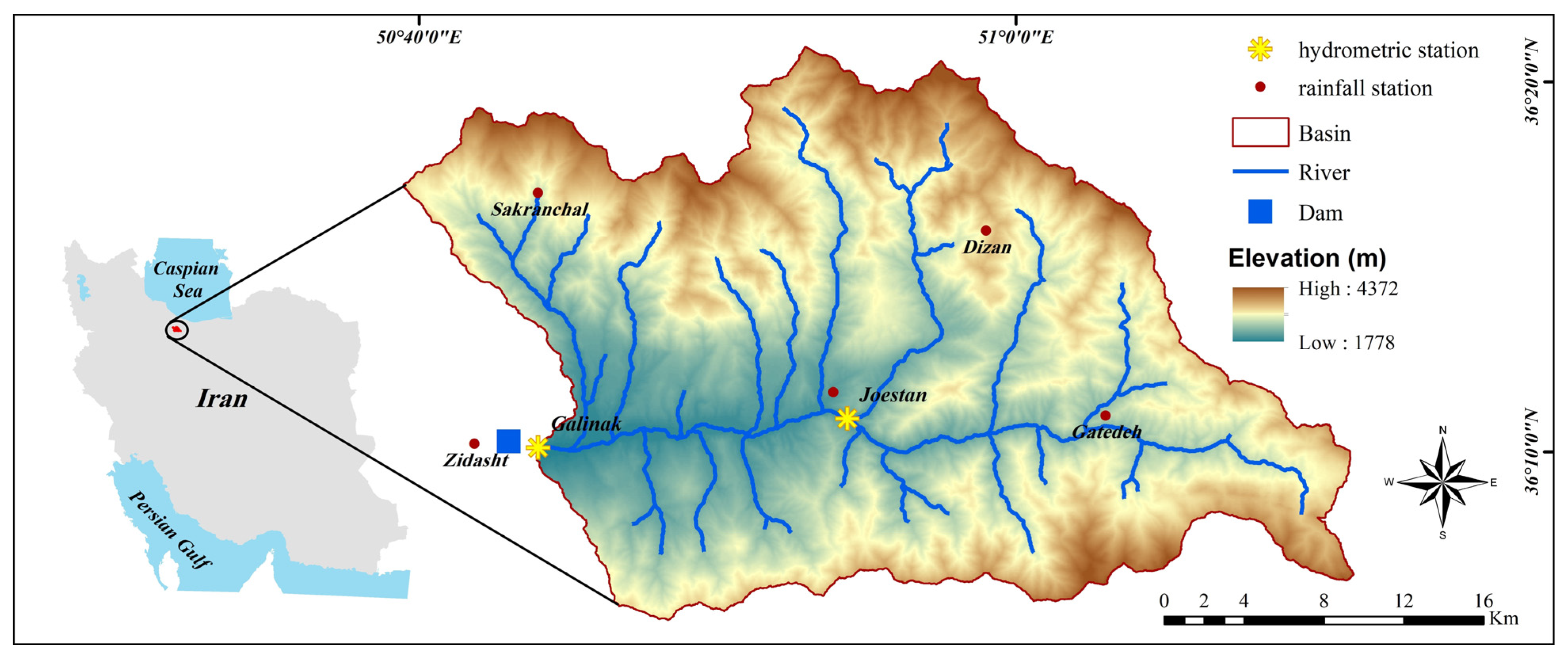
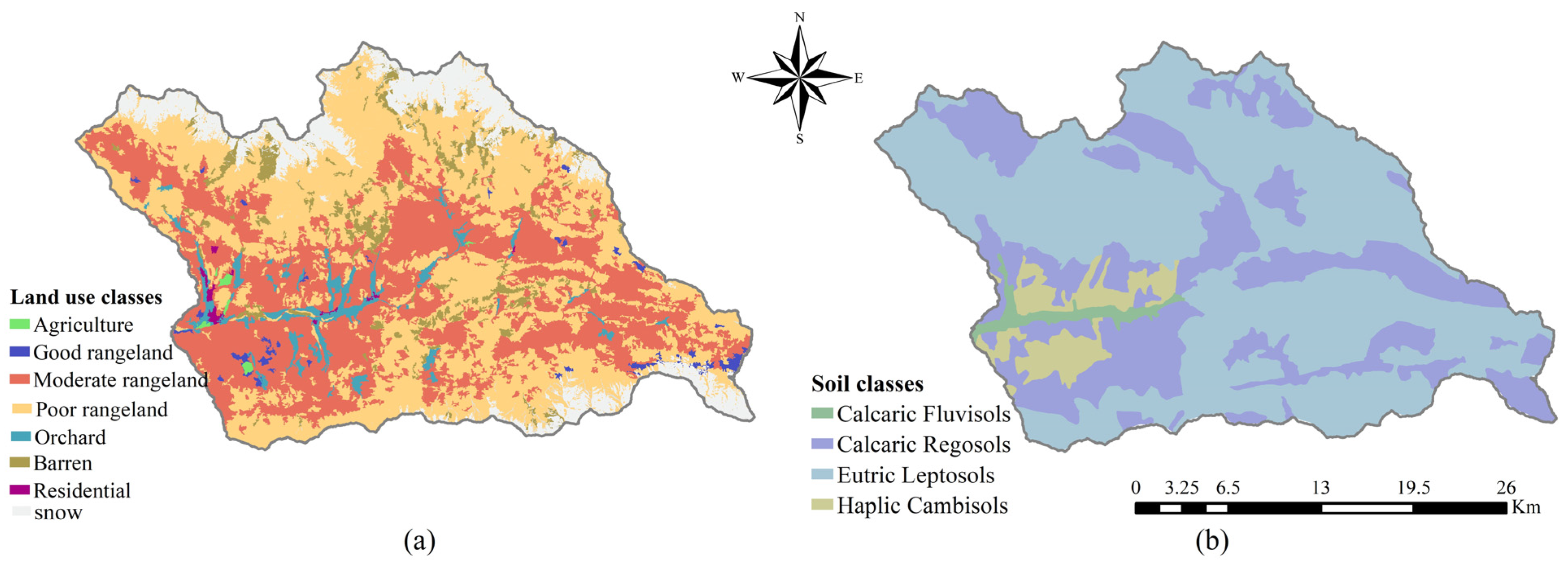
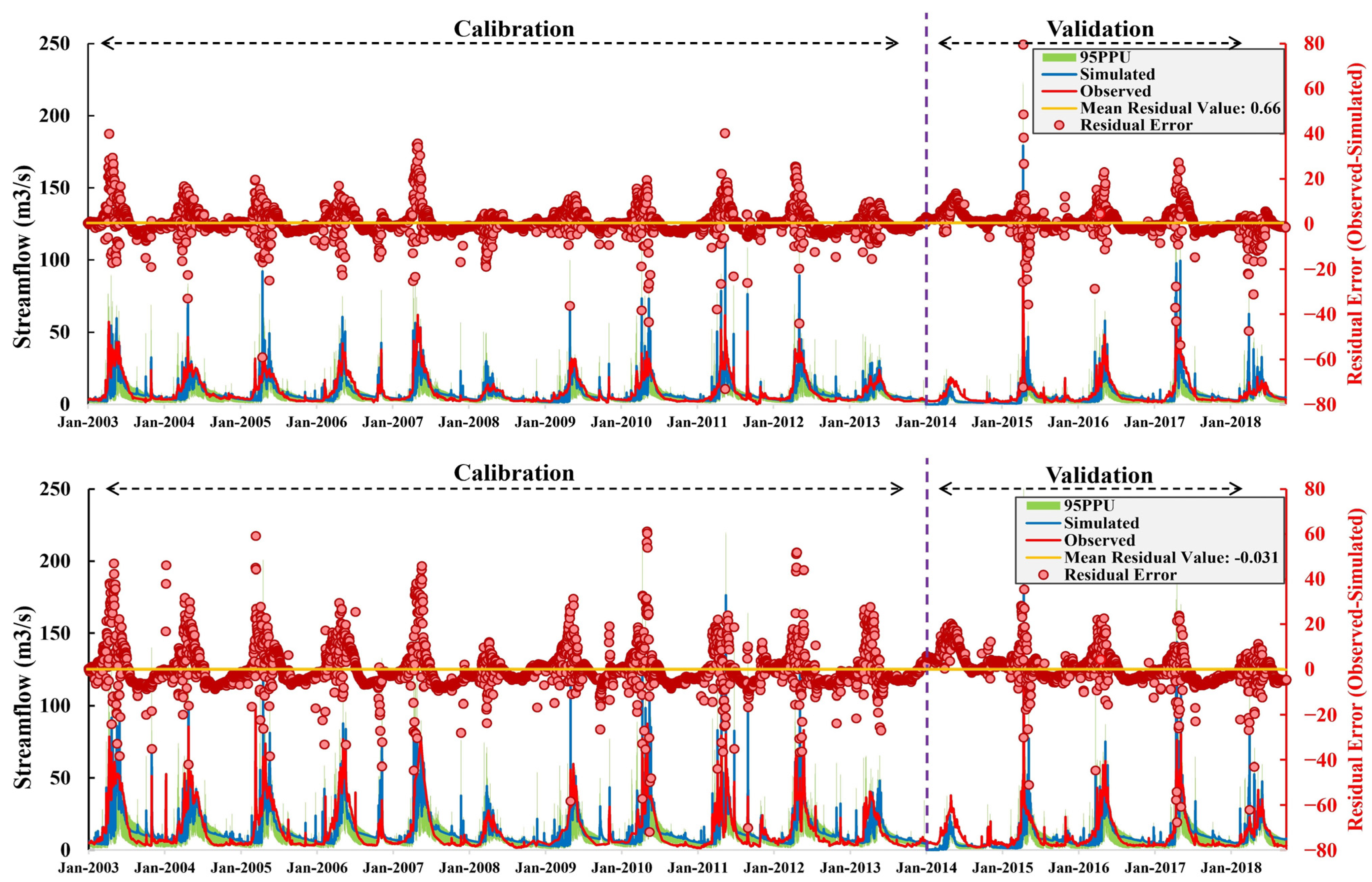

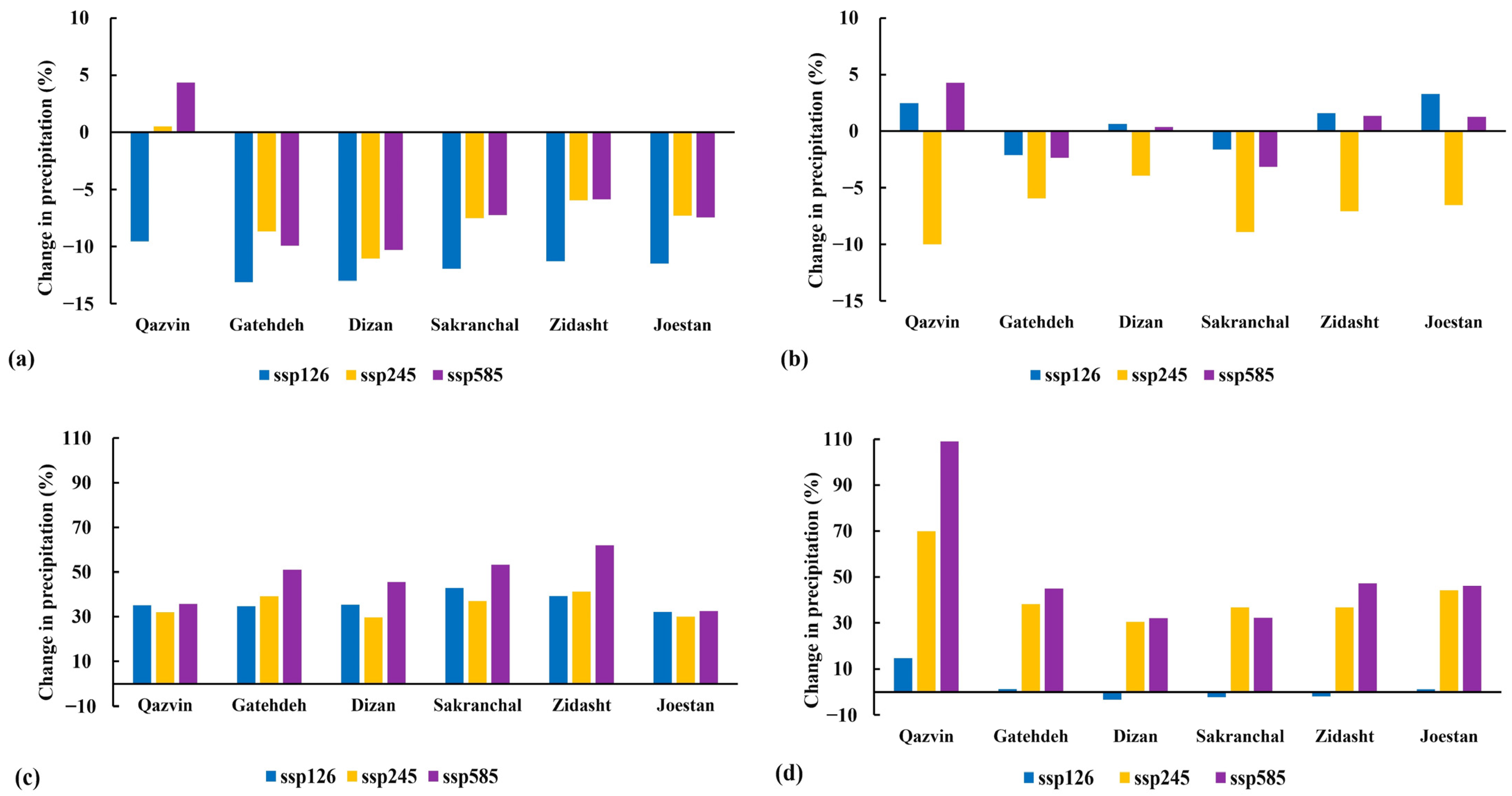
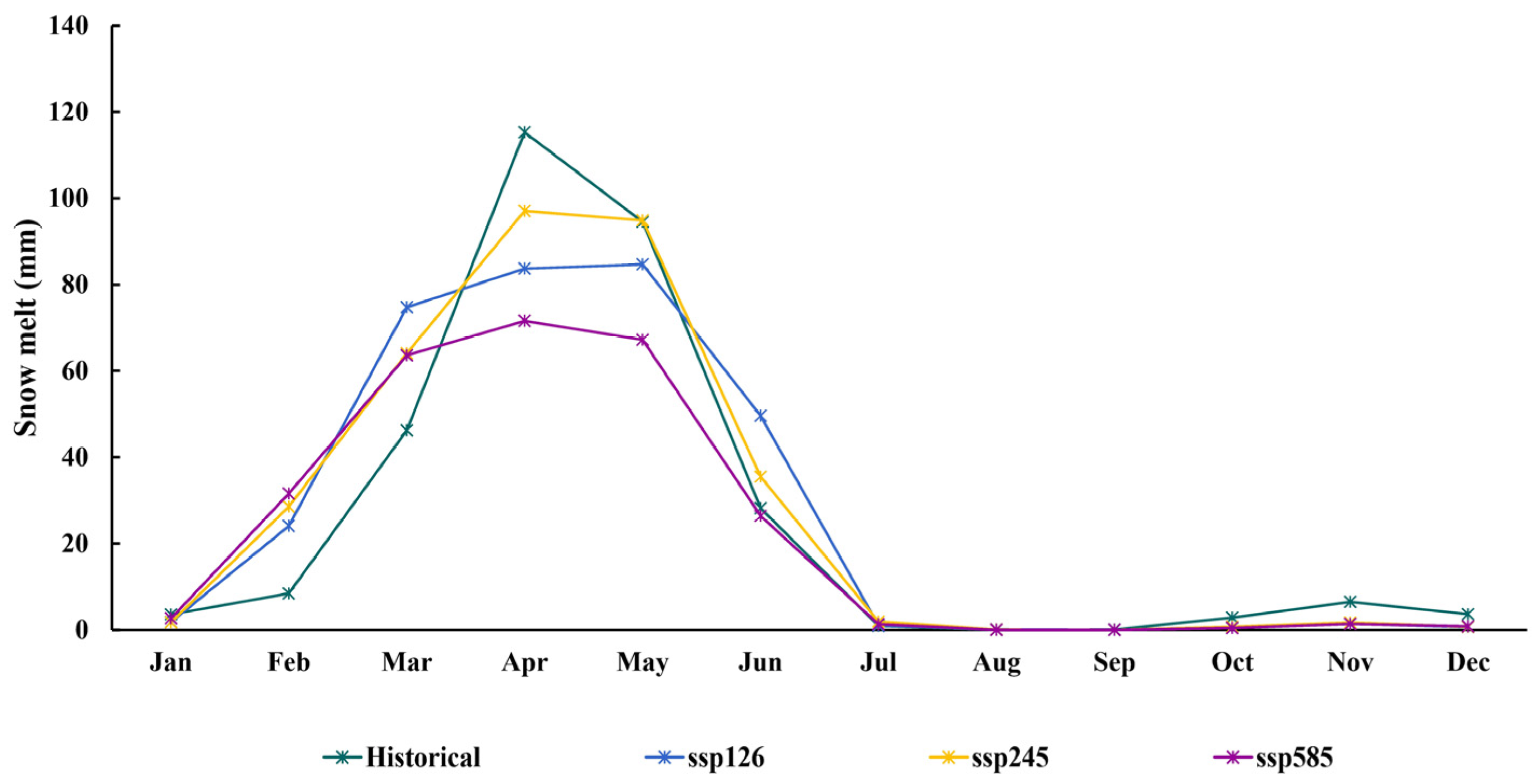
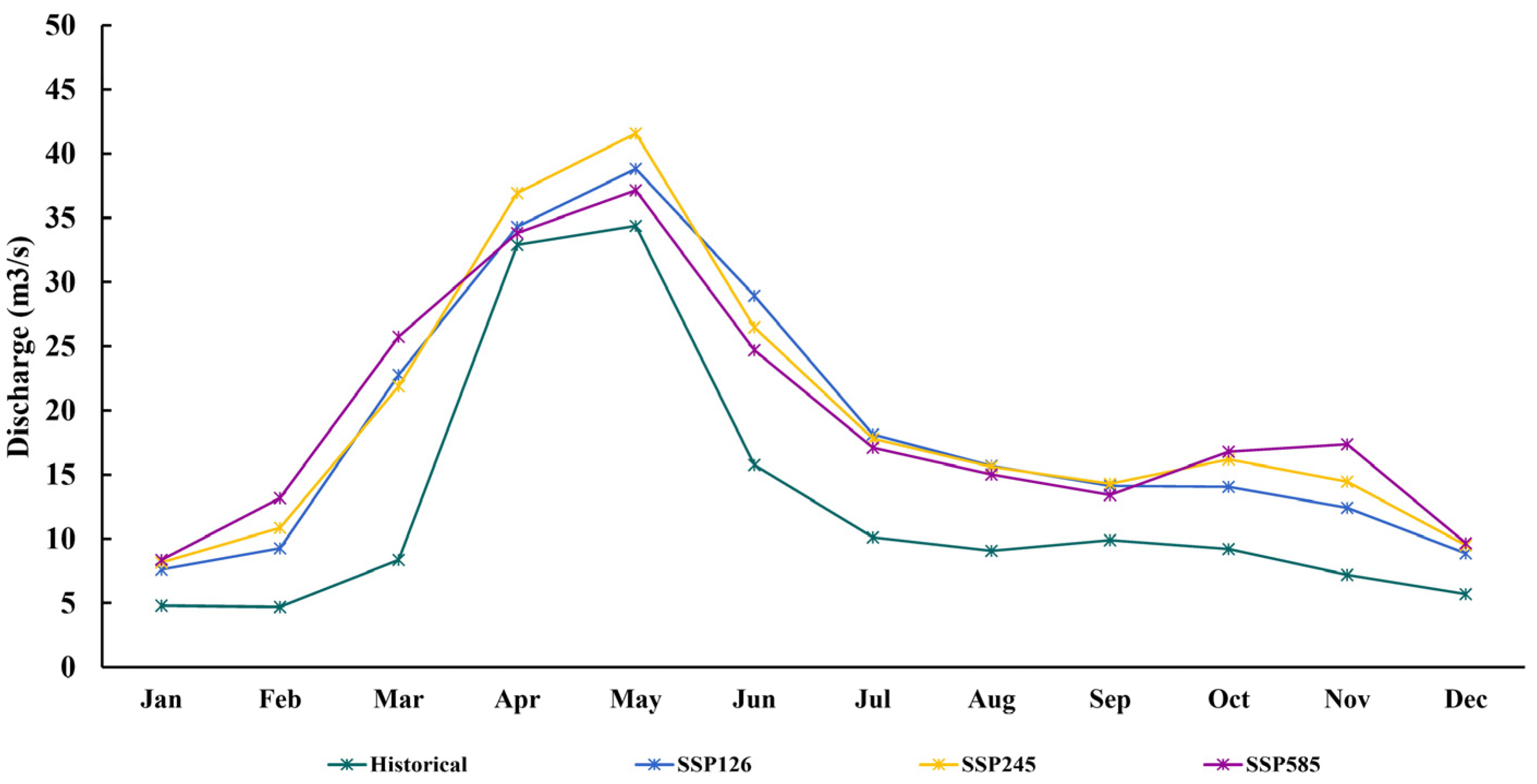
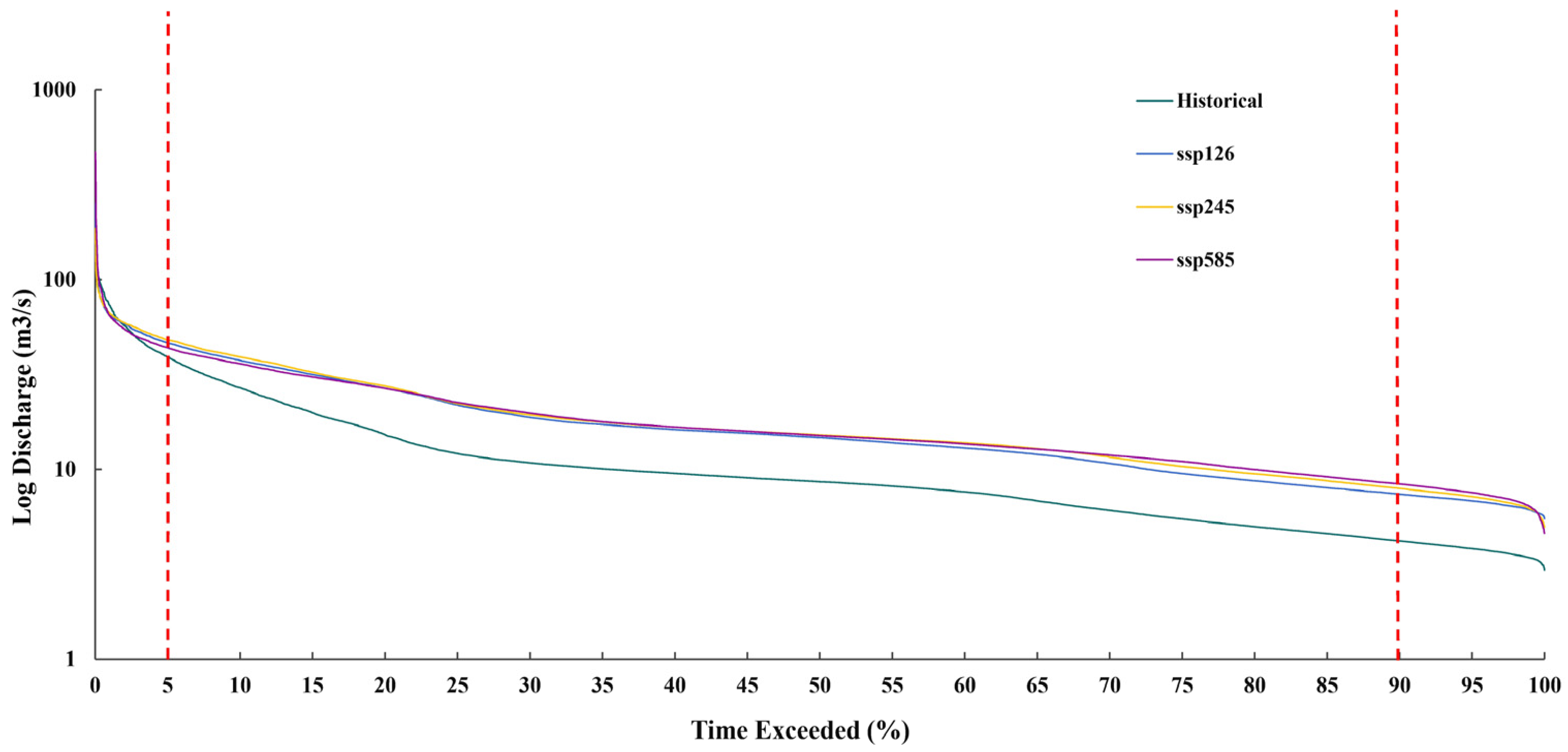

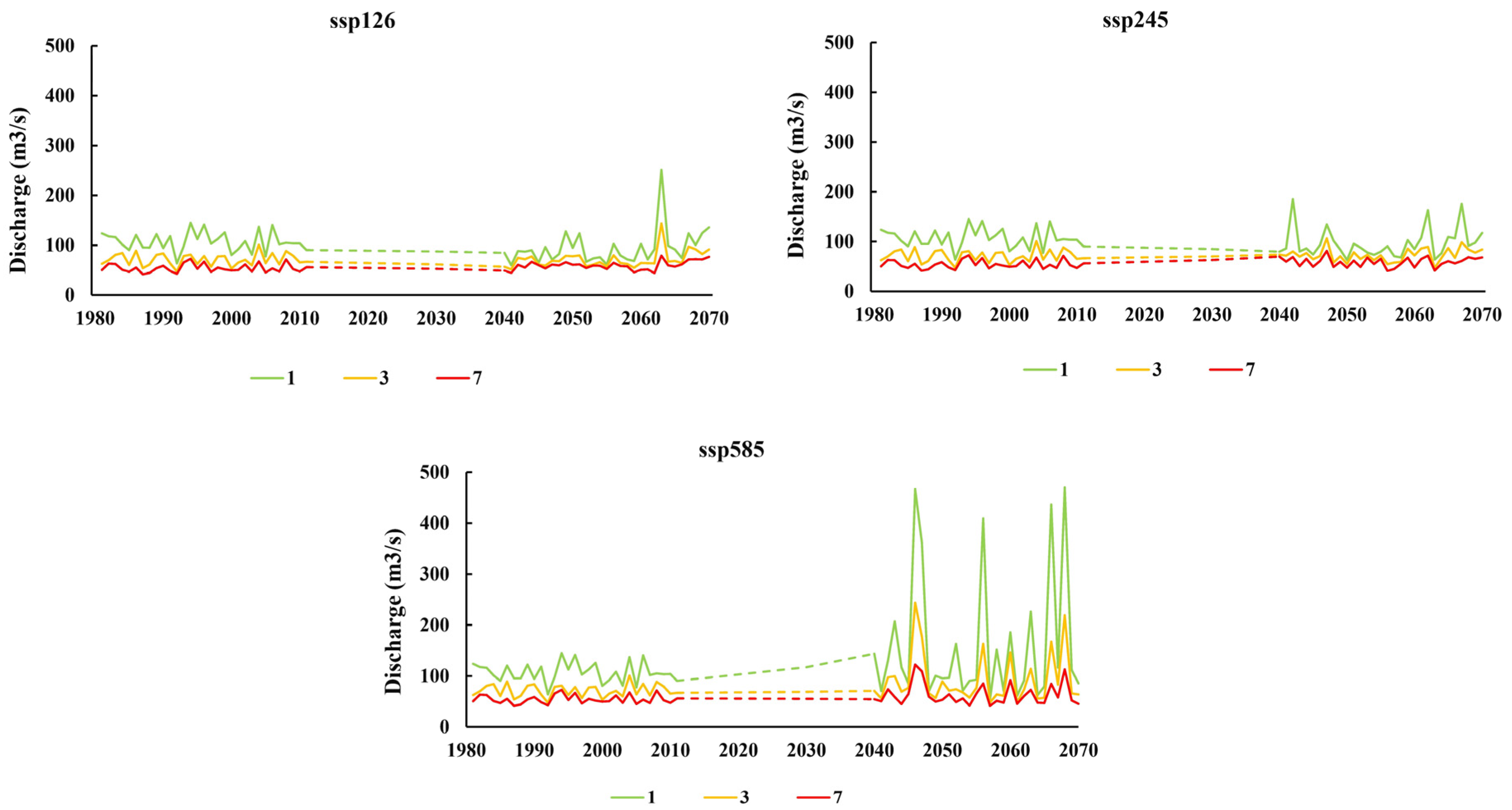
| Parameter | Min. Value | Max. Value | Fitted Value |
|---|---|---|---|
| Maximum snow melting rate during the summer solstice. | 0 | 3.5 | 2.4 |
| Snowfall temperature | 1 | 2.5 | 2.46 |
| Initial SCS curve number II | −0.05 | 0.05 | −0.03 |
| Soil evaporation adjustment factor | 0 | 0.95 | 0.76 |
| Threshold depth for return flow (mm) | 0 | 700 | 38.5 |
| Baseflow alpha (days) | 0 | 0.013 | 0.005 |
| Snow melt temperature | 0 | 3 | 1.87 |
| Minimum melt rate for snow (winter solstice) | 0 | 2 | 0.35 |
| Metrics | Joestan | Galinak | ||
|---|---|---|---|---|
| Calibration | Validation | Calibration | Validation | |
| P-factor | 0.71 | 0.59 | 0.66 | 0.67 |
| R-factor | 0.66 | 0.72 | 0.8 | 0.81 |
| R2 | 0.62 | 0.58 | 0.57 | 0.63 |
| NSE | 0.60 | 0.48 | 0.55 | 0.5 |
| PBIAS (%) | 6.4 | 12.6 | −1.8 | 3.1 |
| Station | Description | Model | Ave. Observed | RMSE | NSE | R2 |
|---|---|---|---|---|---|---|
| Qazvin | Max temperature (°C) | Calibration | 20.8 | 0.3 | 0.99 | 0.99 |
| Validation | 21.8 | 0.5 | 0.99 | 0.99 | ||
| Min temperature (°C) | Calibration | 6.6 | 0.3 | 0.99 | 0.99 | |
| Validation | 7.4 | 0.5 | 0.99 | 0.99 | ||
| Precipitation (mm) | Calibration | 27.6 | 6.44 | 0.89 | 0.93 | |
| Validation | 24.8 | 5.5 | 0.89 | 0.9 | ||
| Gatehdeh | Precipitation (mm) | Calibration | 62.19 | 10.78 | 0.93 | 0.95 |
| Validation | 62 | 11.5 | 0.9 | 0.9 | ||
| Dizan | Precipitation (mm) | Calibration | 67.28 | 10.12 | 0.95 | 0.95 |
| Validation | 69.6 | 12.6 | 0.92 | 0.91 | ||
| Sakranchal | Precipitation (mm) | Calibration | 40.12 | 5.25 | 0.96 | 0.97 |
| Validation | 42.5 | 8.7 | 0.9 | 0.9 | ||
| Zidasht | Precipitation (mm) | Calibration | 40.25 | 5.18 | 0.96 | 0.97 |
| Validation | 40.1 | 10.17 | 0.86 | 0.86 | ||
| Joestan | Precipitation (mm) | Calibration | 40.26 | 6.74 | 0.95 | 0.97 |
| Validation | 47.49 | 10.26 | 0.88 | 0.88 |
| Period | Evapotranspiration (mm) | Precipitation (mm) | Surface Runoff (mm) | Lateral Flow (mm) | Snowfall (mm) | Snowmelt (mm) |
|---|---|---|---|---|---|---|
| Historical | 322.5 | 825.5 | 152.14 | 114.92 | 462.48 | 360.47 |
| SSP126 | 517.7 | 1259.8 | 145.87 | 200.04 | 549.46 | 414.97 |
| SSP245 | 538 | 1310.8 | 148.76 | 210.54 | 548.58 | 417.02 |
| SSP585 | 561.6 | 1320.9 | 137.47 | 216.16 | 465.61 | 345.37 |
Disclaimer/Publisher’s Note: The statements, opinions and data contained in all publications are solely those of the individual author(s) and contributor(s) and not of MDPI and/or the editor(s). MDPI and/or the editor(s) disclaim responsibility for any injury to people or property resulting from any ideas, methods, instructions or products referred to in the content. |
© 2024 by the authors. Licensee MDPI, Basel, Switzerland. This article is an open access article distributed under the terms and conditions of the Creative Commons Attribution (CC BY) license (https://creativecommons.org/licenses/by/4.0/).
Share and Cite
Haji Mohammadi, M.; Shafaie, V.; Nazari Samani, A.; Zare Garizi, A.; Movahedi Rad, M. Assessing Future Hydrological Variability in a Semi-Arid Mediterranean Basin: Soil and Water Assessment Tool Model Projections under Shared Socioeconomic Pathways Climate Scenarios. Water 2024, 16, 805. https://doi.org/10.3390/w16060805
Haji Mohammadi M, Shafaie V, Nazari Samani A, Zare Garizi A, Movahedi Rad M. Assessing Future Hydrological Variability in a Semi-Arid Mediterranean Basin: Soil and Water Assessment Tool Model Projections under Shared Socioeconomic Pathways Climate Scenarios. Water. 2024; 16(6):805. https://doi.org/10.3390/w16060805
Chicago/Turabian StyleHaji Mohammadi, Marziyeh, Vahid Shafaie, Aliakbar Nazari Samani, Arash Zare Garizi, and Majid Movahedi Rad. 2024. "Assessing Future Hydrological Variability in a Semi-Arid Mediterranean Basin: Soil and Water Assessment Tool Model Projections under Shared Socioeconomic Pathways Climate Scenarios" Water 16, no. 6: 805. https://doi.org/10.3390/w16060805
APA StyleHaji Mohammadi, M., Shafaie, V., Nazari Samani, A., Zare Garizi, A., & Movahedi Rad, M. (2024). Assessing Future Hydrological Variability in a Semi-Arid Mediterranean Basin: Soil and Water Assessment Tool Model Projections under Shared Socioeconomic Pathways Climate Scenarios. Water, 16(6), 805. https://doi.org/10.3390/w16060805







